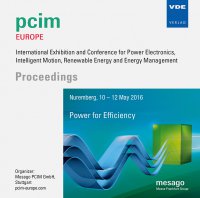Evaluation of a Unidirectional Three-Phase Rectifier Based on the Third Harmonic Injection Concept in Comparison to a VIENNA Rectifier
Konferenz: PCIM Europe 2016 - International Exhibition and Conference for Power Electronics, Intelligent Motion, Renewable Energy and Energy Management
10.05.2016 - 12.05.2016 in Nürnberg, Deutschland
Tagungsband: PCIM Europe 2016
Seiten: 8Sprache: EnglischTyp: PDF
Persönliche VDE-Mitglieder erhalten auf diesen Artikel 10% Rabatt
Autoren:
Makoschitz, Markus; Ertl, Hans (Vienna University of Technology, Institute of Energy Systems and Electrical Drives, Power Electronics Section, Gusshausstr. 27-29, 1040 Wien, Vienna, Austria)
Hartmann, Michael (Schneider Electric Power Drives GmbH, Vienna, Austria)
Inhalt:
One of the most attractive rectification circuit for three-phase AC-to-DC conversion is the very well known three-phase diode (B6) bridge rectifier. Simplicity of circuit and design, high efficiency as well as robustness and cost-efficiency are major beneficial outcomes of this type of rectifier. For applications which require high input current quality (low THD and a high power factor) active three-phase rectifiers (e.g. VIENNA rectifier) have to be used which in general are dedicated systems fully replacing the passive rectifier. For specific applications which do not require a controlled output voltage (e.g., AC drives), however, a concept seems to be attractive, which opens the opportunity to optionally extend an existing B6 rectifier to a low harmonic input stage. In order to emphasize additional benefits and drawbacks of the optional third harmonic injection circuit (employing two half-bridge branches) compared to an active unidirectional rectifier commonly used in industry (e.g. the VIENNA rectifier), this work is engaged in an opposed comparison of different performance indices as system efficiency, switching/conduction losses, rated inductor power etc.


